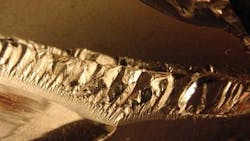U. of Cambridge process may greatly reduce cost of solar-grade silicon
Cambridge, England--A new process developed by scientists at the University of Cambridge has the potential to drive down the cost of manufacturing solar-grade silicon by a factor of five or more.
One factor holding back the growth of today’s photovoltaic (PV) industry is the high cost of the solar-grade silicon on which it currently depends. The Cambridge researchers are developing and up-scaling a new process for making solar-grade silicon that they estimate will be 80% more efficient in terms of energy consumption and cost and will generate 90% less carbon dioxide (CO2).
Based on a procedure known as the FFC Cambridge process developed by Derek Fray and colleagues in Cambridge’s Department of Materials Science and Metallurgy, the new modification pioneered by Antony Cox has extended FFC to silicon for the first time and is now in its final research and development stages.
Currently, the manufacturing methods commonly used to make crude silicon produce some 10 tons of CO2 for every ton of silicon produced, and the refinement stage (the so-called Siemens process) produces a further 45 tons of CO2 as well as toxic gases.
The two-stage process Cox has been developing uses white sand and calcium chloride as raw materials. First, tablets of compressed sand are immersed into the calcium chloride electrolyte and heated to 900°C. The silicon in sand is present as an oxide; during the FFC process, the oxygen atoms are ionized, migrate to the anode, and are discharged as oxygen—the only by-product of the reaction. Sand is not easy to reduce to silicon and Cox has spent the past four years solving this fundamental challenge and upscaling the first stage of the process.
In the second stage, an electrorefining process within the same cell takes silicon from 99.99% purity to 99.9999% purity. “Preliminary investigations were very encouraging and we are now developing the second stage,” says Cox.
“Many attempted scale-ups for other processes have been thwarted due to the sheer difference in scale between a pilot plant and a commercial plant where unforeseen problems are often revealed,” says Cox. “In this process we plan to use many independent smaller cells allowing more control, rather than one huge plant. This should facilitate the transition to a commercial ‘process.'”
Based on the results of an independent economic survey, he believes that the process will drive down the cost of manufacturing solar-grade silicon from around the current $40–200/kg to a maximum of $8/kg, making solar power a more affordable option to generate power.
Source: http://www.cam.ac.uk/research/features/solar-grade-silicon-at-low-cost/

John Wallace | Senior Technical Editor (1998-2022)
John Wallace was with Laser Focus World for nearly 25 years, retiring in late June 2022. He obtained a bachelor's degree in mechanical engineering and physics at Rutgers University and a master's in optical engineering at the University of Rochester. Before becoming an editor, John worked as an engineer at RCA, Exxon, Eastman Kodak, and GCA Corporation.
